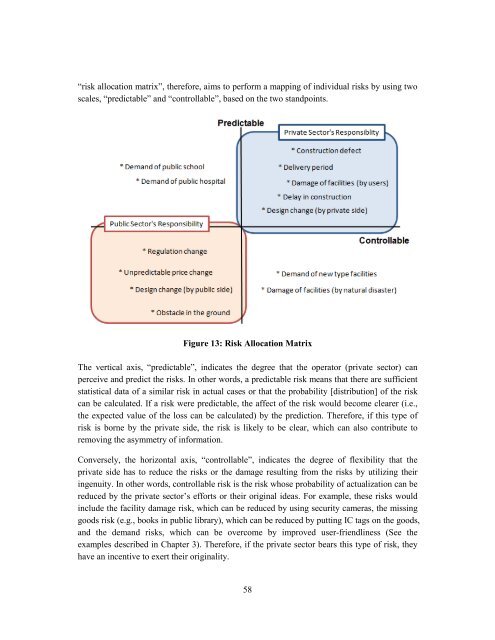Risk Management and Governance for PFI Project ... - Title Page - MIT
Risk Management and Governance for PFI Project ... - Title Page - MIT
Risk Management and Governance for PFI Project ... - Title Page - MIT
You also want an ePaper? Increase the reach of your titles
YUMPU automatically turns print PDFs into web optimized ePapers that Google loves.
“risk allocation matrix”, there<strong>for</strong>e, aims to per<strong>for</strong>m a mapping of individual risks by using two<br />
scales, “predictable” <strong>and</strong> “controllable”, based on the two st<strong>and</strong>points.<br />
Figure 13: <strong>Risk</strong> Allocation Matrix<br />
The vertical axis, “predictable”, indicates the degree that the operator (private sector) can<br />
perceive <strong>and</strong> predict the risks. In other words, a predictable risk means that there are sufficient<br />
statistical data of a similar risk in actual cases or that the probability [distribution] of the risk<br />
can be calculated. If a risk were predictable, the affect of the risk would become clearer (i.e.,<br />
the expected value of the loss can be calculated) by the prediction. There<strong>for</strong>e, if this type of<br />
risk is borne by the private side, the risk is likely to be clear, which can also contribute to<br />
removing the asymmetry of in<strong>for</strong>mation.<br />
Conversely, the horizontal axis, “controllable”, indicates the degree of flexibility that the<br />
private side has to reduce the risks or the damage resulting from the risks by utilizing their<br />
ingenuity. In other words, controllable risk is the risk whose probability of actualization can be<br />
reduced by the private sector’s ef<strong>for</strong>ts or their original ideas. For example, these risks would<br />
include the facility damage risk, which can be reduced by using security cameras, the missing<br />
goods risk (e.g., books in public library), which can be reduced by putting IC tags on the goods,<br />
<strong>and</strong> the dem<strong>and</strong> risks, which can be overcome by improved user-friendliness (See the<br />
examples described in Chapter 3). There<strong>for</strong>e, if the private sector bears this type of risk, they<br />
have an incentive to exert their originality.<br />
58

















